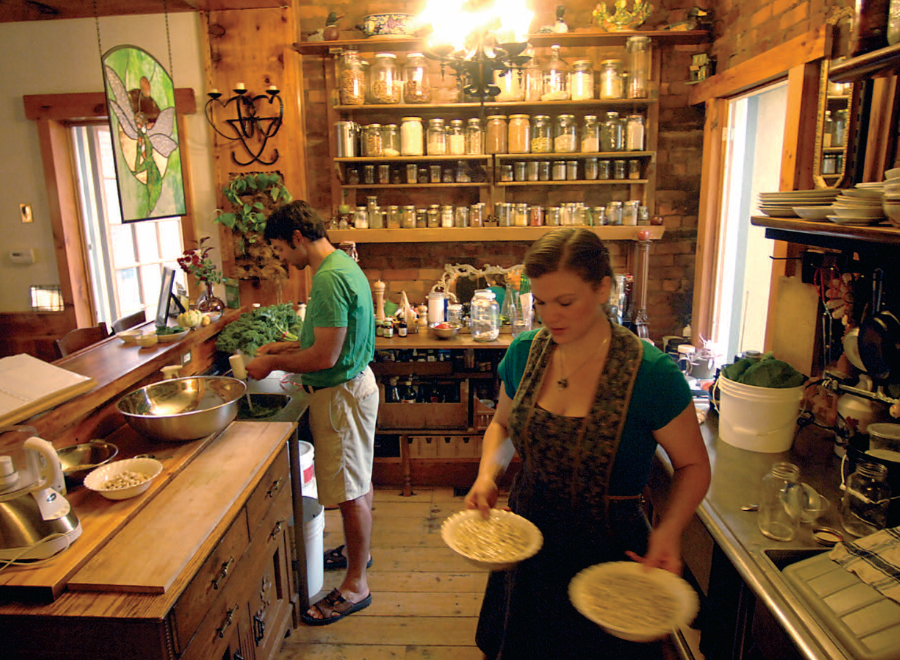In the same way that “Make love not war” was a slogan for the turbulent 1960s and “Think outside the box” was on everyone’s lips in the 2000s, “Living off the grid” is becoming a catchphrase for the climate-conscious 2010s. Despite the currency the phrase ay have in the environmental movement, however, for most of us the idea of radically changing the way we live so we’re not a drain on creation remains just that — an idea. But increasingly, off-the-grid pioneers are showing that with a little savvy and sacrifice, it can be done.
Peter Ormond and Barbara Maccaroni are proof you don’t have to dwell in a shack with a goat on the root to live off the grid — or very nearly off it. They live in Hamilton, a city of 500,000 in Ontario’s industrial heartland, where Maccaroni is a raw food and vegan chef and Ormond is an engineer and federal Green Party candidate. For them, living off the grid is a way to rein in the cost of living while recognizing the need to survive in a future without fossil fuels.
You may unsubscribe from any of our newsletters at any time.
For Ormond and Maccaroni, living off the grid coincides with their ongoing effort to live simply. They don’t own a stove, clothes dryer, air conditioner or microwave. They cook on a hotplate, and when that’s not up to the task, they use a neighbour’s or a relative’s stove. “I’ve had to use someone else’s oven about a half a dozen times over the last year or so,” says Maccaroni.
The couple have also insulated their house so well that they no longer need a furnace. If it gets too cold, they use space heaters to warm up the room they are in. Ormond says the practice of warming a single room instead of an entire house is fairly common in Denmark, where they attended the 2009 Copenhagen climate conference.
Their electricity use has plummeted. That’s good for their pocketbook, even though Canada has some of the cheapest electricity rates in the world. It’s also good for the environment: according to the Paris-based Atomic Energy Agency, Canadians are among the highest per capita energy users in the world.
But their life off the grid isn’t just about reducing the energy that comes into their house. It’s also about using their house to create and export energy back into the grid.
The Province of Ontario has promised to shut down coal-fired power plants by 2014 and rely more on cleaner renewable energy sources like wind, the sun and water. A year ago, the province announced a program that allows consumers who invest in renewable energy sources to sell excess electricity they produce. Participants receive a guaranteed fixed rate for a period of about 20 years, which helps them recover their investment and then make a return on it.
Maccaroni and Ormond were thrilled when they heard about the program. It gave the couple, who already had a solar water heater in their home, the incentive they needed to move into solar energy in a big way.
They spent roughly $15,000 to buy and install solar panels, and estimate they will recoup the cost in eight years. After that, they expect to make a profit of about $100 a month for the remaining 12 years of their contract.
Maccaroni and Ormond believe solar panels will be as commonplace in future households as energy-gulping appliances are today. They want to inspire others to change their lifestyles, and they seem to be getting through: their home is part of the annual Doors Open Hamilton event, and to date over 500 people have toured it. “I think it’s important to be the model that you wish to see others follow. It’s okay to preach it, but it’s most important that people actually walk their talk. It’s definitely what we’re striving to do,” says Maccaroni.
Three hundred kilometres northeast of Hamilton, in the rolling Ontario lake country of the Haliburton Highlands, carpenter David Baillie and his wife, Heather Golba, have a house full of electronics and top-end appliances. “We have high-speed Internet, satellite television, a full-size fridge and as many lights as we want to use,” says Baillie, a carpenter who owns a construction company in the village of Tory Hill. But not a single power line leads into their home. Solar panels generate most of their electricity. In the depths of winter, when they need a little extra, a propane-fired backup generator kicks in — but only intermittently. Much of the time, Baillie and Golba have more juice than they can use. Unlike Maccaroni and Ormond, however, they don’t sell it back to the grid. They bank it in batteries.
“We don’t live a monastic life,” says Baillie. “I wanted to see how close to a normal existence we could have off-grid. We chose a model that I wanted to be able to replicate if other people were interested.”
Baillie enjoys the rural life and freedom from zoning restrictions on things like wood stoves and house design. However, the real reason he and his wife chose not to be grid-connected is that he feels there is “zero motivation to conserve if you’re connected to the grid.”
Baillie continues, “The grid is like a great big safety net. You can get as much power as you want and not care. You can have six people stay over for a week, and it won’t matter. It’s much easier to be aware when everything you do has an impact. Everything.” He observes that being grid-connected means more than gorging on electricity. It also means that an environmental cost has been paid for the thousands of kilometres of cable, towers, substations and clear-cut hydro corridors it has taken to deliver the electricity from the generating station to your home.
When you rely on power you produce yourself, and the gauge on the storage batteries says you’re starting to run low, “You really start caring about how much power you use. It ties you in to the natural world.”
The bond doesn’t come without a pricetag, though— those heavy-duty deep-cycle batteries, for example, cost several thousand dollars and need to be replaced every 10 years, more often if they’re not sized correctly. And it took some creative and risky financing to build their home— personal loans, a line of credit and “a whole pile of credit cards” —because, as they discovered, some banks are squeamish about providing mortgages to homes that are not grid-connected.
Baillie and Golba may live off the grid, but they don’t live in isolation. So what happens when six people do come to stay for a week in the winter? Baillie says the propane-powered generator kicks in, the gas oven fires up and everyone stays warm and well fed. But for Baillie, the coziness is tempered by a cold reality: the sound of the generator coming to life is audible evidence they’re using more energy than they produce. “I feel a personal sense of failure,” he says.
As more people begin to share Baillie’s anguish over excess energy consumption, “off the grid” will become less of a buzzword and more of a prescription for sustainable living. Whether the solution is to go partly off-grid or all the way, both options represent major advances in making the planet more livable for future generations.
***
This story first appeared in The United Church Observer’s November 2010 issue with the title “Losing their grid.”














